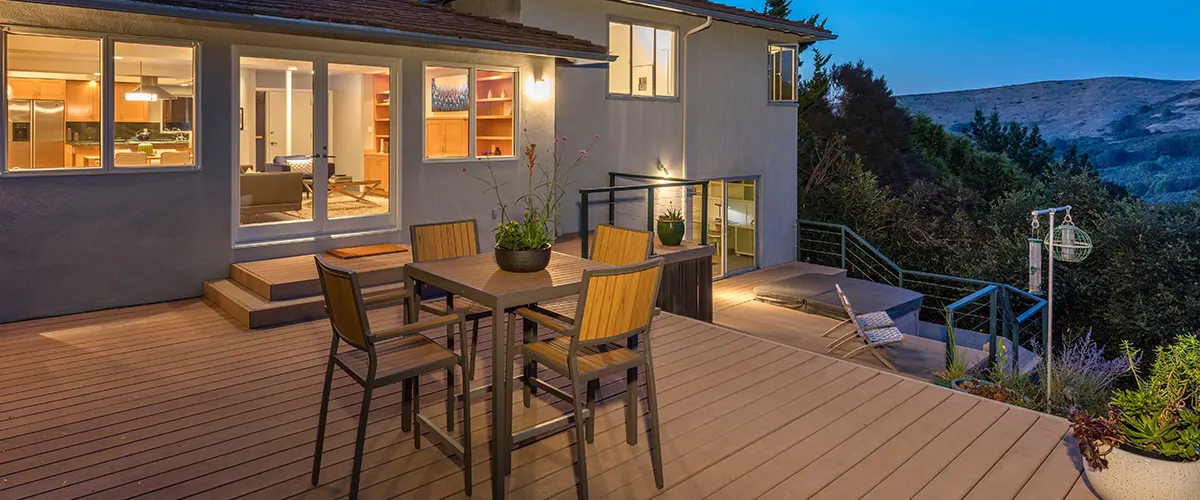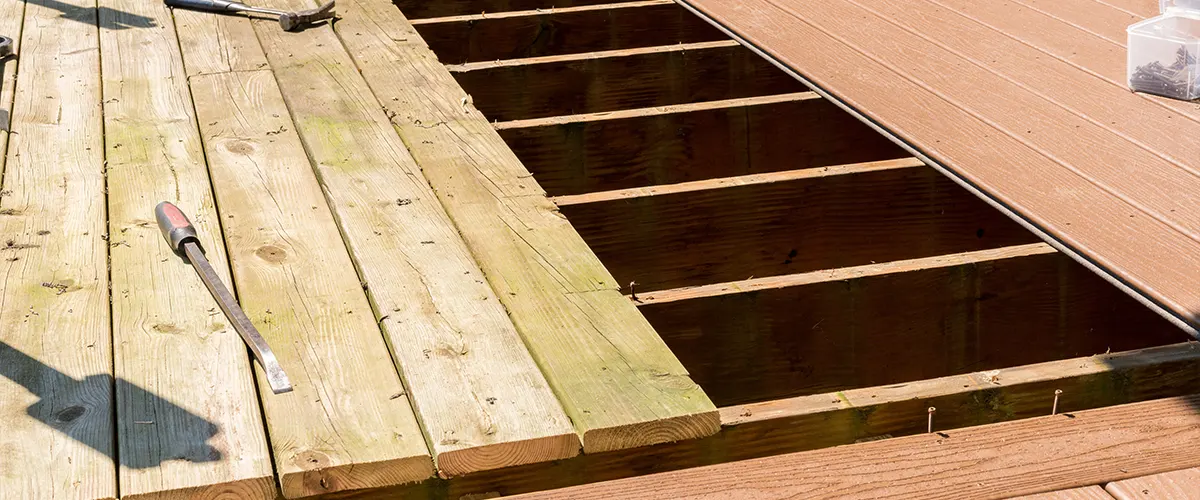If you decided it’s time to get a deck or upgrade an existing one, you probably wonder what your options are.
Most homeowners don’t know how many choices there are for their decking options, but this article aims to change that.
Let’s look at composite decking options to help get you ahead of the curve when choosing your new low-maintenance decking material.
Let’s dive in and look at your decking options!

Composite Decking
Composite decking is a building product made of wood fibers, plastic, and bonding agents. Manufacturers heat the mixture at high temperatures, press it together to form various shapes and lengths and let it cool to create a hard and heavy decking material.
But not all composite decking has the same quality.
Composite decking manufacturers split this material into three main types of composite decking:
- Uncapped composite
- Capped composite
- PVC
Uncapped Composite Decking
This type of decking was the original composite decking introduced around 30 years ago. It’s made of wood and plastics and was an early version of what we have today. Although several manufacturers still make uncapped composite decking, not many deck professionals offer this as an option.
Capped Composite Decking
Most composite decking installed today is capped composite. The core of the capped composite is still a mix of wood and plastics, but the outer shell makes this product a much better option than the uncapped composite.
The plastic capping on the outside of the board protects the core from the elements. These deck boards have a long life span and even come with a 25-year limited rot, stain, and fade warranty.
With a wide range in pricing to meet many budgets, capped composite decking is an excellent choice for your decking project. Capped composite also comes in various colors and grain patterns.
PVC Decking
PVC decking is the best long-term investment on the market. While the other choices in composite decking all have a wood mixture in the core, PVC decking is all plastic. This creates a deck board that will never rot.
PVC decking has a very similar capping to the capped composite decking and is also available in many colors and gain patterns. PVC decking offers a limited lifetime rot warranty and 50-year fade and stain.
This decking material is a top choice for your upcoming decking project.
Here at Hankins Decks LLC, we specialize in installing capped composite and PVC decking options, as they’re by far the best decking materials.
But your choices don’t end here.
Decking Profiles
Grooved Edges
Grooved decking has a notch cut into the side of the deck board. This groove allows the installer to attach the hidden fastener clips onto the deck board. The grooves are hard to see and take no strength away from the deck board.
Non-grooved Edges (Or Solid Edges)
Solid Bottom
Scalloped bottom deck boards usually fall under the economy range with composite decking. To drop the decking board’s price point, manufacturers shave grooves in the bottom of the deck board. They are as heavy as the solid bottom composite but have only one usable side.
When it comes to scalloped composite decking vs solid bottom decking, both options are similar, but professionals will most often choose the solid composite deck boards.
Composite Decking Pricing
Composite decking pricing is probably one of the main concerns our customers have. Homeowners expect composite decking to be quite expensive, but it’s nothing like that.
In fact, certain wood decks are more expensive and require extensive maintenance to upkeep them.
Let’s see some average prices for different brands of composite decking:
Trex
A typical 24′ x 12′ deck will cost you $5,749 with good boards, $7,722 with better boards, and $9,336 with the best boards. Check out Trex decking price calculator here.
Fiberon
Fiberon has a lot of materials options. For the same deck dimensions, it costs around $6,000 for materials only. Fiberon’s decking price calculator is also a great tool to discover how much you should expect to pay for your decking boards.
| Decking Line | Grade | Average Cost | Cost Per Square Foot |
|---|---|---|---|
| Good Life | Good | $5,968 - $6,215 | $10.85 - $11.30 |
| Sanctuary | Better | $7,810 - $8,261 | $14.20 - $15.02 |
| Paramount | Best | $9,075 - $9,213 | $16.05 - $16.79 |
| Concordia-Symmetry | Best | $8,663 - $9,048 | $15.75 - $16.45 |
| Concordia-Horizon | Best | $8,663 - $9,048 | $15.75 - $16.45 |
Timbertech
Timbertech boards are also split into categories.
- TimberTech AZEK - Best
- TimberTech Pro - Better
- TimberTech EDGE - Good
For their Pro Legacy Collection, homeowners pay around $7,700. Check out their pricing calculator here.
Conclusion
How does someone sort through manufacturers, colors, materials, and price points to decide what decking option works best for their home, taste, budget, and long-term plans? Start this endeavor, and you’ll find yourself spending weeks trying to decide.
This is where a knowledgeable contractor can stand out from the crowd.
Get in touch today and consult with a professional deck builder!


